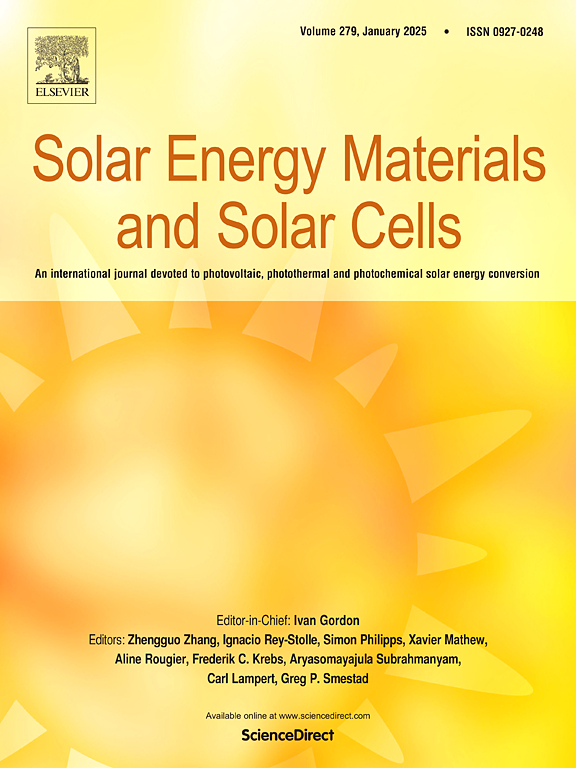双波段电致变色智能窗用聚苯胺/WO2.86复合薄膜
IF 6.3
2区 材料科学
Q2 ENERGY & FUELS
引用次数: 0
摘要
双波段电致变色(EC)材料由于其独特的选择性管理近红外(NIR)和可见光(VIS)光谱的能力,在当代研究中受到了极大的关注。然而,设计和开发双频EC薄膜面临着巨大的挑战,主要源于合适的高性能材料的有限可用性。在我们的研究中,我们成功地合成了聚苯胺(PANI)/WO2.86双频EC薄膜,该薄膜具有四种不同色调(浅蓝、黄绿、深蓝和深绿)的可逆颜色过渡。采用含氧空位缺陷的聚苯胺(PANI)纳米棒(NRs)和WO2.86纳米线(NWs)作为活性EC组分制备了这些薄膜。值得注意的是,P-W5薄膜在VIS和NIR区域都表现出良好的双频调制能力。其快速的切换动态(着色/漂白时间为10 s/13.5 s),高着色效率(65.3 cm2C-1)和强大的循环稳定性(在3000次循环后保持72.2%的容量)可归因于电极材料的3D多孔纳米结构和高效的Li+离子扩散。此外,采用PANI/WO2.86双带EC材料的EC智能窗原型显示出显着的隔热性能,与传统双层玻璃窗相比,模型室内的温度降低了14.4°C。本研究为双频电子材料的设计提供了一种可行的策略,并为其在智能窗口和智能显示中的应用铺平了道路。本文章由计算机程序翻译,如有差异,请以英文原文为准。

Polyaniline/WO2.86 composite film for dual-band electrochromic smart windows
Dual-band electrochromic (EC) materials have gained significant attention in contemporary research due to their unique capacity to selectively manage near-infrared (NIR) and visible (VIS) light spectra. Nevertheless, the endeavor to design and develop dual-band EC films poses a formidable challenge, primarily stemming from the limited availability of suitable high-performance materials. In our study, we have successfully synthesized polyaniline (PANI)/WO2.86 dual-band EC films, which exhibit reversible color transitions across four distinct hues (light blue, yellow-green, dark blue, and dark green). These films were fabricated using PANI nanorods (NRs) and WO2.86 nanowires (NWs) containing oxygen vacancy defects as the active EC components. Notably, the P-W5 film demonstrated good dual-band modulation capabilities in both VIS and NIR regions. Its swift switching dynamics (coloring/bleaching times of 10 s/13.5 s), high coloring efficacy (65.3 cm2C-1), and robust cycling stability (retaining 72.2 % of its capacity after 3000 cycles) can be attributed to the electrode material's 3D porous nanostructure and efficient Li+ ion diffusion. Additionally, the EC smart window prototype, incorporating PANI/WO2.86 dual-band EC materials, exhibited remarkable thermal insulation properties, resulting in a temperature reduction of 14.4 °C within a model room compared to traditional double-glazed windows. This investigation presents a viable strategy for the design of dual-band EC materials and paves the way for their application in smart windows and intelligent displays.
求助全文
通过发布文献求助,成功后即可免费获取论文全文。
去求助
来源期刊

Solar Energy Materials and Solar Cells
工程技术-材料科学:综合
CiteScore
12.60
自引率
11.60%
发文量
513
审稿时长
47 days
期刊介绍:
Solar Energy Materials & Solar Cells is intended as a vehicle for the dissemination of research results on materials science and technology related to photovoltaic, photothermal and photoelectrochemical solar energy conversion. Materials science is taken in the broadest possible sense and encompasses physics, chemistry, optics, materials fabrication and analysis for all types of materials.
 求助内容:
求助内容: 应助结果提醒方式:
应助结果提醒方式:


